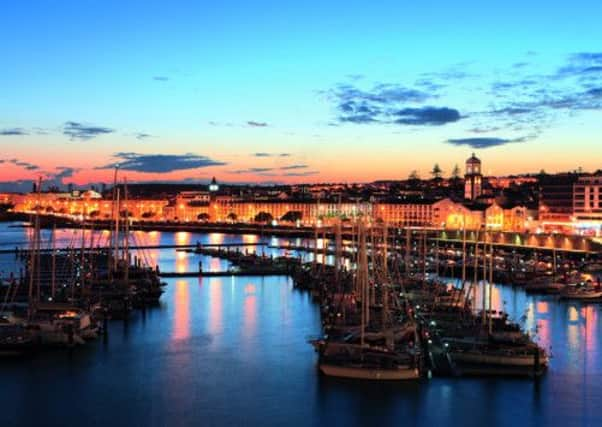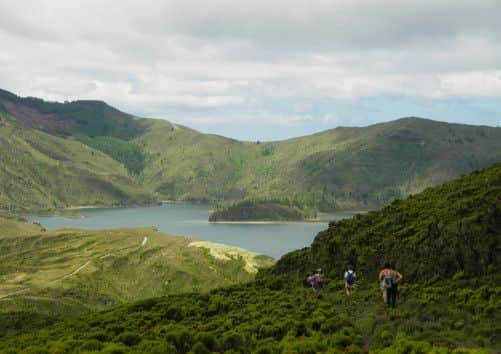Craters for all tastes


We’re on São Miguel the “Green Island”, driving to Sete Cidades, the “Kingdom of the Seven Cities” where our guide, Luis, has promised an amazing view – a scene that has inspired lovers throughout the ages, he says.
But as we climb the winding road, the fog thickens. When we reach the top it is difficult to see anything.
Advertisement
Hide AdAdvertisement
Hide AdJust as all hope is fading, rays of sunlight break through the dense white soup to reveal a dizzying vista. A huge crater filled with lush vegetation unfolds below. Nestled in the middle, is a pair of lakes – one green, one blue.


Legend has it the tears of a pair of thwarted lovers filled the two lakes which took on the colours of each of their eyes. Looking out at the sun shimmering on the serene waters below, I begin to see why this spot has evoked such a magical aura through the ages.
First settled in the early 15th-century and sat in the mid-Atlantic at the ends of the known world, the nine Azores islands exuded a dark power over the waves of traders, conquerors and pirates who swept through them. The isolated location, jagged black coastlines and dramatic volcanic landscapes may have elicited awe and fear in early adventurers, but they are now the main attractions for the few visitors who now come here.
The Portuguese islands are among the best places in the world to go whale watching, with sperm, blue and killer whales regularly found in the nearby waters. But it is the onshore activities that we have come to sample, with the lush vegetation and volcanic craters promising a stunning backdrop for a host of activities including mountain biking, hiking, paragliding, caving and kayaking.
Advertisement
Hide AdAdvertisement
Hide AdSão Miguel is the most populated island in the Azores, and its capital Ponta Delgado is the largest town. Its port was the centre for the export of oranges to England in the 18th-century, and the wealth this trade brought is still evident in the palatial buildings of its old town. However, today, life here has a slower pace and wandering the quiet cobbled streets is like stepping back 20 years.
The first stop on our trip through the archipelago is Furnas and onto bikes to explore the area around its large lake. As we pedal through the surrounding hills, the landscape is lush, with explosions of blue hydrangeas and orange ginger lilies, giant green palms and fields of yams lining the mist-shrouded slopes around us.
We stop at the Terra Nostra, an elegant botanical gardens dating back to the 18th-century. At the centre of avenues of century-old trees, beds of colourful geraniums, gigantic lily pads and fern-lined water channels, is a large muddy brown thermal pool.
We dive in, the metallic water feels heavy yet silky soft. Only the promise of lunch draws us out of the warm cocoon.
Advertisement
Hide AdAdvertisement
Hide AdBack at the lakeside hot springs, we watch chefs from the local restaurants pull large pots of the local specialty, Cozidos, from the bubbling grey earth.
The traditional meat and vegetable stew – after eight hours cooking in the ground – is a wonderfully tender blend of flavours.
The next day we get further from the crowds with a hike up Lagoa do Fogo, “Fire Lake” in the centre of the island. We cut through fields of eucalyptus, then into a densely wooded area of tall pines. After that we follow a water channel bordered with tropical palms and ferns before the path opens up to jagged greened peaks and cliffs plunging into a large lake. Only the colony of seagulls, who breed up here,share the majestic view.
We briefly join the birds for the 30-minute flight to our next island – Terceira. The Terceirans love celebrations and we have arrived at the time of the Holy Spirit festivals, the traditional event to mark survival of the long winter. Each village we travel through has a procession of brass band and later feasts are held in the street.
Advertisement
Hide AdAdvertisement
Hide AdThe locals are acutely aware of just how delicately balanced their community is. When an earthquake hit in 1980, 70 per cent of the buildings on the island were wiped out and most of the historic centre of Angra do Heroísmo, the oldest city in the Azores. The remarkable reconstruction efforts earned it UNESCO protection and are testament to the will of the people.
The last island on my trip is Faial, one of the smallest islands and the spot of the last major eruption, perhaps now the Azores’ most stunning natural attraction: the Capelinhos volcano. From 1957 to 1958 a series of eruptions pushed almost a mile and a half of new land out of the sea and created a desolate, black moonscape. A lonely lighthouse survived and sits on the edge of layers of gnarled brown and grey rocks.
It is impossible not to feel awestruck by the power of nature in this bleak and dusty landscape, and it is something of a relief to return to the picaresque port of Horta, a favourite stopping point for Atlantic yachtsmen. The custom is for sailors to leave a painting on the harbour wall for luck, making the seafront a mosaic of colours.
Falling asleep to the sound of masts whistling shrilly in the wind, we awake to yet another stunning view – it is the neighbouring island of Pico, the jagged line of its classic conical volcano outlined against a fiery orange sunrise. Unfortunately this is the final destination and its slopes will have to remain unexplored – along with the treasures of the other islands – until next time.
Getting there
Advertisement
Hide AdAdvertisement
Hide AdSATA airlines (www.sata.pt) run weekly direct flights to the Azores from Gatwick from April to October and year round via Lisbon. Flights start from £336 return including taxes.
Atlantic Holidays (www.atlanticholidays.net) do seven night packages to the Azores from £469 per person, including direct return flights from London Gatwick and accommodation at the Hotel Vila Nova in Ponta Delgada.
Futurismo adventures (www.futurismo.pt) organize a host of activities and tours. Guided walking tours start at £61per person.
For more information on the Azores see: www.visitazores.com.